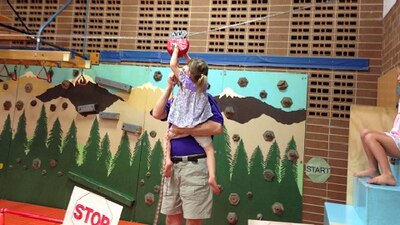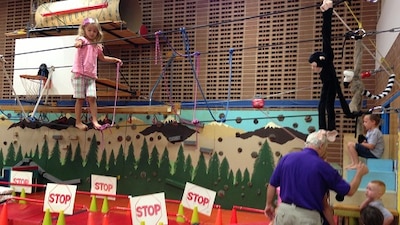Dan Higgins, a retired physical education teacher, is six-foot-two with white hair and a white mustache. Given his stature and his no-nonsense manner, it’s hard to imagine him as a young Kansas boy climbing trees and playing Tarzan in the 1950s.
But that’s exactly where he got the inspiration for Rope World, a popular program he began at Longmont’s Rocky Mountain Elementary School 34 years ago and continues to run today.
To understand the long-standing appeal of Rope World, imagine setting kids free in a gym packed with ropes, ladders, zip lines, tunnels and cargo nets. Aside from a few basic rules, they’re allowed to be as daring as they like.
Earlier this week, about two-dozen children from Longmont, Boulder, Broomfield and even Fort Morgan scampered around the mat-covered gym as Higgins doled out high fives or offered a helping hand to tentative explorers. Some kids shimmied up the 18-foot hanging rope, drawing a round of applause when they rang the bell at the top. Others shot across the zip line again and again, trying it backwards when they wanted a change of pace.
“As a kid I played outside all the time, had treehouses, rope bridges from tree to tree, swinging ropes,” said Higgins, who began teaching at Rocky Mountain in the late 1970s. “When I came here… I just realized kids didn’t really… play in their environment.”
His goal was to bring the outdoors of his youth inside for students to experience. He started with a cargo net, a rope bridge and a zip line, and Rope World quickly became part of his physical education curriculum.
“I happened to be at the right place at the right time with the right principal and she just said, ‘dream.’”
In 1982, a few years after establishing Rope World for his students, he opened it up to the public the day after Thanksgiving.
“We were swamped that morning, about 50 kids and 50 parents,” he said.
In the three decades since, Higgins, and a small army of volunteers have run Rope World for two-week sessions four times a year (the current session ends Friday). The cost for an hour of climbing, swinging and zipping has risen from about $1 per child to $4, but most parents still consider it a bargain.
In addition to four public sessions a day, Rope World also provides closed sessions for daycare centers, camps and birthday parties. The program has attracted visitors from as far away as Nebraska.
On Tuesday, Kellie Ward, of Fort Morgan, reminisced about her own experiences at Rope World as she watched her two young daughters tackle the cargo net.
“There’s not much I remember about my childhood…but I remember this,” she said. “So it’s fun to bring my girls.”
A blast from the past
Parents like Rope World for the same reasons they like bounce house playgrounds and trampoline gyms. It’s fun for their kids and a good outlet for their endless energy. But many also appreciate that it’s a throwback of sorts, harkening back to a time when play was less structured and liability waivers didn’t preface every activity.
Kate Repsher, who came to Rope World with her two- and five-year-old daughters earlier this week, said, “They just get a lot energy out and do some stuff that they can’t do anywhere else”
In today’s world, she added, “Everybody’s so protected.”
Nearby, Verna Wallberg, the mother of two boys, mused about how uniquel Rope World is.
“We moved here from Dallas a year ago and Dallas has everything… but I’ve never seen this before.”
Noting her six-year-old’s excitement upon making it across a rope bridge strung between two cargo nets about 10 feet off the ground, she talked enthusiastically about the program’s confidence-boosting powers.
“At first they’re a little nervous, but then they overcome that.”
Higgins said Rope World also gives parents the confidence to step away from their children and let them master skills they probably wouldn’t in a natural environment. Exhibit A: The 18-month-old girl in a purple sun dress who gamely braved the zip line after being lifted up so she could reach the handles.
“We empowered her to do something there was no way that mom was going to allow her to do by herself,” said Higgins. “So we had that space of drawing parents away from kids … That’s invaluable, one of the most invaluable parts of Rope World.”
In addition to exercising young muscles and cultivating courage, both Higgins and Stephen Hoel, principal of Rocky Mountain Elementary, say Rope World also works out the brain.
“I think it ties their minds and their bodies together,” said Hoel. “It’s really more than crawling around. It’s a lot of planning.”
Higgins said it also provides foundational skills in academic subjects like math.
For example, he said, “Math skills are distances: ‘How far do I have to jump before I land on that mat? When do I have to let go here? Where do I need to put my foot on the next rung of the ladder?’” We just don’t think of them as math concepts, but they are the beginning blocks of math.”
Liability
Rope World is hardly a slick commercial operation. Parents don’t have to sign liability forms upon entering and Higgins simply tucks the cash from admission fees into a box decorated with Spiderman paper.
Still, the possibility of injuries or lawsuits isn’t lost on Higgins or Hoel. That’s one reason why Higgins starts out every session by laying out the rules. He’ll tick them off again for latecomers and doesn’t hesitate to turn down the radio and blow his whistle to stop errant behavior.

“We’ve had a few kids get a fractured wrist or fractured leg,” said Higgins. “It does happen, but I mean, monkeys fall out of trees.”
While there was once an unsuccessful lawsuit after a child broke a leg after falling awkwardly from a series of monkey bar-like rings, there have been few complaints over the years.
When Hoel took over as principal of Rocky Mountain six years ago, he said he wasn’t nervous about having Rope World at his school. In fact, it was a place he’d taken his own kids many times.
“I was very comfortable with it,” he said. Then, he added, “It is definitely something that we have to be careful about.”
While Hoel believes the benefits outweigh any risks, it’s a mindset that’s not universal.
Higgins said schools in Fort Lupton and Brighton at one point approached him about creating something similar in their districts, but the idea didn’t get much support. In one case, the school board voted down the plan.
“I think the liability is a big part for principals,” he said.
The future of Rope World
Higgins, 62, retired from teaching five years ago, but still supervises Rope World during the eight weeks a year it operates. Not only is the program self-supporting, it brings in $3,000 to $4,000 a year to support less profitable school activities such as the after-school jogging club or computer classes.
Higgins clearly relishes his time with the kids, often learning their names almost instantly. Still, he’s slowing down a little. He says he’ll probably run the program for at least a few more years, but will drop the October session this year.

“The parents would have me keep it going till I’m 95,” he joked.
While Hoel said it might be possible some other staff member could take over Rope World when Higgins steps down, he doesn’t sound convinced.
“There’s a lot more to it than just standing out there and supervising it. Dan knows so much about it. There’s some knowledge there that we don’t have.”
Then, he added with a laugh, “I certainly don’t want to be the person who is in charge when it goes away because it is very, very popular.”
